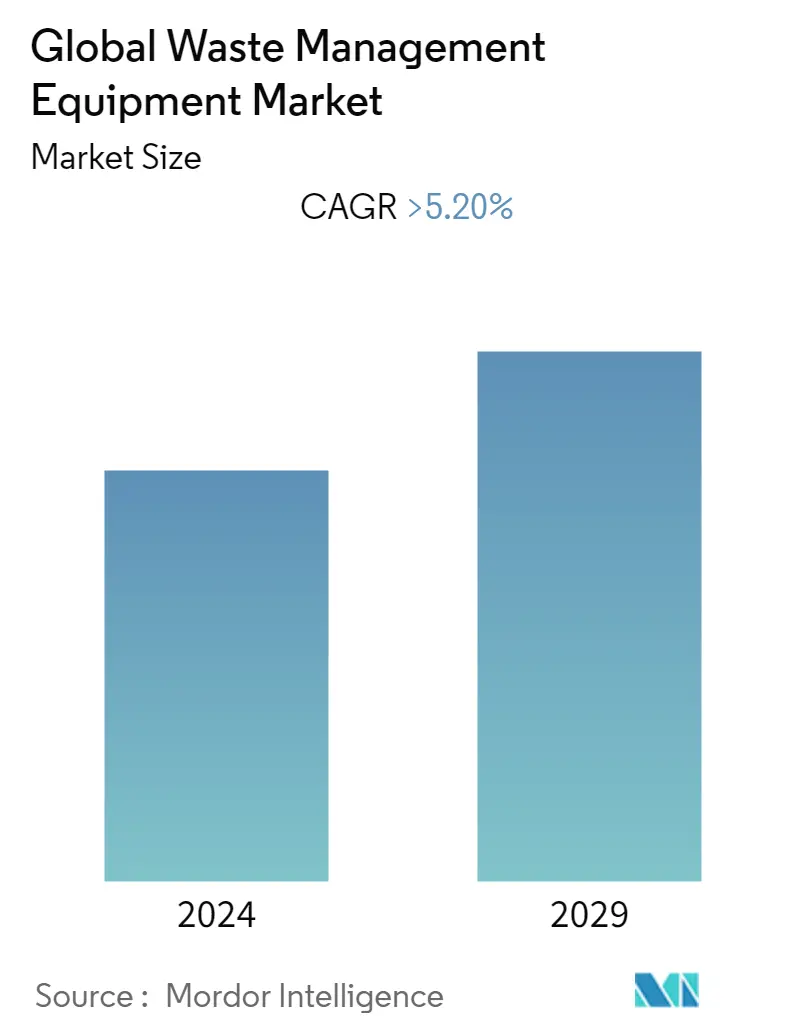Market Size of Global Waste Management Equipment Industry

| Study Period | 2020 - 2029 |
| Base Year For Estimation | 2023 |
| CAGR | > 5.20 % |
| Fastest Growing Market | Asia-Pacific |
| Largest Market | North America |
| Market Concentration | Medium |
Major Players
*Disclaimer: Major Players sorted in no particular order |
Need a report that reflects how COVID-19 has impacted this market and its growth?
Waste Management Equipment Market Analysis
The Global waste management equipment market is expected to record a CAGR of more than 5.2% during the forecast period, 2022-2027.
COVID-19 impacted the waste management industry from the focus of segment shift; during the lockdown, the residential segment generated more waste than industrial and commercial centres, as industries and offices were partially or completely shut. Industrial and commercial waste production fell drastically due to the slowdown in manufacturing activity. Hazardous waste production grew with higher production from the pharmaceutical and medical sectors. The COVID-19 pandemic triggered a zero-waste approach that requires members of the EU to recycle waste between 70-80% while declining GHG emissions attributed to toxic waste disposal and incineration techniques as per the European Commission.
Existing hazardous waste treatment capacity in developing countries was overwhelmed, leading to stockpiling and potentially inadequate disposal. Municipal waste had increased in volume, effectively overwhelming existing waste collection and disposal systems. A reduction in recycling activities was reported which further compounded challenges in the collection and disposal of municipal waste. The study conducted by AMSA Group in 2020 states that in Milan (Italy), the institution of strict lockdown led to a decline in the total waste production by 27.5%. However, recycling of waste increased by 1% compared to 2019 the same period, whereas street bins declined by 38.2%. The month of confinement saw a 16.65% drop in municipal waste.
According to the World Bank, by 2050, waste production will be 73% higher than in 2020. This increase will be mostly driven by middle-income countries in which waste generation will nearly double in the next three decades, though low- and many- high-income countries will contribute significantly to the growing volume. As of 2021, only 77% of global solid waste is collected and 33% of it is openly dumped. The situation in low-income countries is particularly alarming, where only 40% of the generated waste is collected and 93% is dumped or improperly managed. A survey conducted by the Institute of Scrap Recycling Industries (ISRI) in 2021 suggests that 66% of Americans would not recycle a product if it's not easy or inconvenient to do so, and the municipal solid waste (MSW) recycling rate in the US remains as low as 35% in the country. As per National Environment Agency (NEA), Singapore, in 2021, about 6.94 million tonnes of solid waste was generated, of which 3.83 million tonnes were recycled. Waste generated by the non-domestic and domestic sectors both increased in 2021, from 4.12 million tonnes and 1.77 million tonnes respectively in 2020, to 5.12 million tonnes and 1.82 million tonnes respectively in 2021, recycled waste attributed to the non-domestic and domestic sectors likewise increased, from 2.81 million tonnes and 0.23 million tonnes respectively in 2020, to 3.58 million tonnes and 0.24 million tonnes respectively in 2021 in Singapore. Thus increasing awareness about proper recycling and disposal of waste is fueling the growth of waste management industry.
